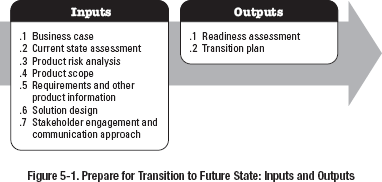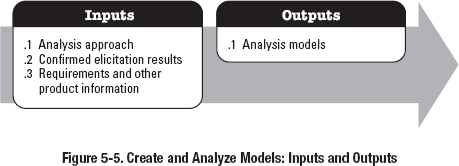5
EXECUTING
The Executing Process Group involves coordinating with stakeholders and using available product information to perform the appropriate business analysis activities. These processes are performed to identify, analyze, and evaluate the components of portfolios, programs, and projects. A significant amount of the work performed in this Process Group is to elicit, model, prioritize, define, verify, and approve all types of product information, ranging from backlogs to user stories and requirements to constraints. This work includes analyzing product risks, defining and evaluating acceptance criteria, and evaluating solution options.
During the product life cycle, program, or project execution, it may be necessary to revisit business problems, goals, and objectives; other portfolio components; and the business analysis plan. Additionally, analysis could trigger change requests to previously understood and approved information. Changes to any of these could reveal additional product information and could cause cascading changes to elicitation activities being performed, stakeholders being engaged, analyzed product information details and priorities, any existing approvals, acceptance criteria, and solution options. A large portion of the business analysis budget and effort will be expended in performing the Executing Process Group processes.
Table 5-1 depicts the relationship between the processes within the Business Analysis Executing Process Group and project management.

A For the business analysis processes, the numbers in parentheses refer to the section numbers for the processes that appear in The Standard for Business Analysis; the other numbers refer to the sections in The PMI Guide to Business Analysis.
5.1 PREPARE FOR TRANSITION TO FUTURE STATE
Prepare for Transition to Future State is the process of determining whether the organization is ready for a transition and how the organization will move from the current to the future state to integrate the solution or partial solution into the organization's operations. The key benefits of this process are that the organization can successfully adopt the changes resulting from the implementation of the new solution or solution component, and that any product or program component or overall program benefit anticipated for the solution can be sustained after it is put into operation. The inputs and outputs of this process are depicted in Figure 5-1.

5.2 PREPARE FOR ELICITATION
Prepare for Elicitation is the process of organizing and scheduling resources and preparing necessary materials for an individual elicitation activity. The key benefits of this process are that the elicitation activities are organized and effectively performed and participants understand up front why they are involved and what is required of them. The inputs and outputs of this process are depicted in Figure 5-2.

5.3 CONDUCT ELICITATION
Conduct Elicitation is the process of applying various elicitation techniques to draw out information from stakeholders and other sources. The key benefit of this process is that it obtains information from the appropriate sources to sufficiently define and elaborate requirements and other product information. The inputs and outputs of this process are depicted in Figure 5-3.

5.4 CONFIRM ELICITATION RESULTS
Confirm Elicitation Results is the process of performing follow-up activities on the elicitation results, determining an appropriate level of formality to use, reviewing with stakeholders for accuracy and completeness, and comparing to historical information. The key benefit of this process is that it validates that stakeholders and the elicitation results were understood during elicitation. The inputs and outputs for this process are shown in Figure 5-4.

5.5 CREATE AND ANALYZE MODELS
Create and Analyze Models is the process of creating structured representations, such as diagrams, tables, or structured text, of any product information to facilitate further analysis by identifying gaps in information or uncovering extraneous information. The key benefit of this process is that it helps convey information in an organized manner that provides clarity and helps achieve correctness and completeness. The inputs and outputs for this process are shown in Figure 5-5.

5.6 DEFINE AND ELABORATE REQUIREMENTS
Define and Elaborate Requirements is the process of refining and documenting requirements and other types of product information at the appropriate level of detail, format, and level of formality required for various audiences. The key benefits of this process are that it (a) helps clarify details about the product information so the team can work from it effectively, and (b) stores the product information in a manner that can be accessed and processed by all stakeholders. The inputs and outputs for this process are shown in Figure 5-6.

5.7 DEFINE ACCEPTANCE CRITERIA
Define Acceptance Criteria is the process of obtaining agreement as to what would constitute proof that one or more aspects of a solution have been developed successfully. The key benefit of this process is that it provides complementary insights that can help refine requirements while providing the basis of a shared understanding for what is to be delivered. The inputs and outputs for this process are shown in Figure 5-7.

5.8 VERIFY REQUIREMENTS
Verify Requirements is the process of checking that requirements are of sufficient quality. The key benefit of this process is that it increases the likelihood that the requirements are stated and/or understood in a way that meets the defined standards for the organization, which in turn enables communication of the requirements to all interested parties and contributes to the quality of the final product. The inputs and outputs for this process are shown in Figure 5-8.

5.9 VALIDATE REQUIREMENTS
Validate Requirements is the process of checking that the requirements meet business goals and objectives. The key benefit of this process is that it minimizes the risks of missing stakeholder expectations or delivering the wrong solution. The inputs and outputs for this process are shown in Figure 5-9.

5.10 PRIORITIZE REQUIREMENTS AND OTHER PRODUCT INFORMATION
Prioritize Requirements and Other Product Information is the process of understanding how individual pieces of product information achieve stakeholder objectives, and using that information, along with other agreed-upon prioritization factors, to facilitate ranking of the work. The key benefits of this process are that it aligns all stakeholders with how the requirements achieve the goals and objectives and determines how to allocate the requirements to iterations or releases accordingly. The inputs and outputs for this process are shown in Figure 5-10.

5.11 IDENTIFY AND ANALYZE PRODUCT RISKS
Identify and Analyze Product Risks is the process of uncovering and examining assumptions and uncertainties that could positively or negatively affect success in the definition, development, and the expected results of the solution. The key benefits of this process are that it supports proactive management of uncertainties in business analysis activities and it uncovers and proactively addresses areas of potential strengths and weaknesses in the product. The inputs and outputs for this process are shown in Figure 5-11.

5.12 ASSESS PRODUCT DESIGN OPTIONS
Assess Product Design Options is the process of identifying, analyzing, and comparing solution design options based on the business goals and objectives, expected costs of implementation, feasibility, and associated risks, and using the results of this assessment to provide recommendations regarding the design options presented. The key benefit of this process is that it allows for informed recommendations of design options. The inputs and outputs for this process are shown in Figure 5-12.

5.13 ESTABLISH RELATIONSHIPS AND DEPENDENCIES
Establish Relationships and Dependencies is the process of tracing or setting linkages between and among requirements and other product information. The key benefits of this process are that it helps in checking that each requirement adds business value and meets the customer's expectations, and it supports monitoring and controlling of product scope. The inputs and outputs of this process are depicted in Figure 5-13.

5.14 SELECT AND APPROVE REQUIREMENTS
Select and Approve Requirements is the process of facilitating discussions with stakeholders to negotiate and confirm which requirements should be incorporated within an iteration, release, or project. The key benefit of this process is that it provides authorization to consider how and when to build all or part of a solution to develop or modify a product. The inputs and outputs for this process are shown in Figure 5-14.

5.15 EVALUATE ACCEPTANCE RESULTS AND ADDRESS DEFECTS
Evaluate Acceptance Results and Address Defects is the process of deciding what to do with the results from a comparison of the defined acceptance criteria against the solution. The key benefit of this process is that it allows for informed decision making about whether to release all or part of a solution and whether to undertake changes, fixes, or enhancements to the product. The inputs and outputs for this process are shown in Figure 5-15.

